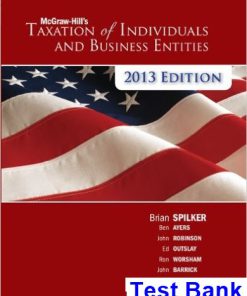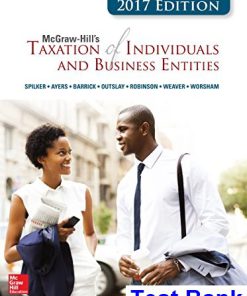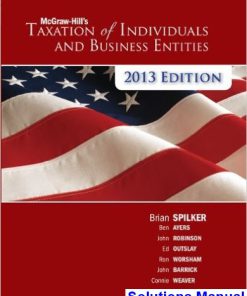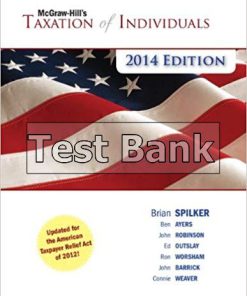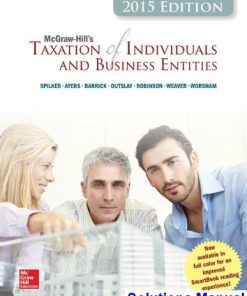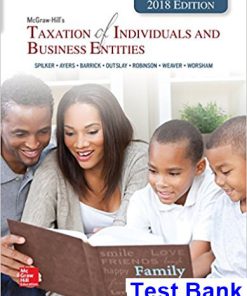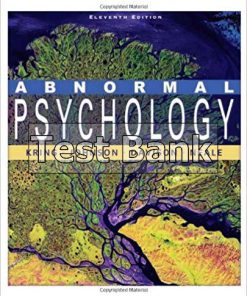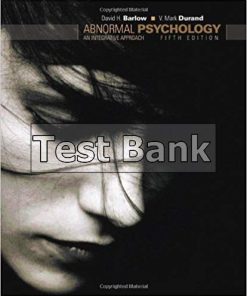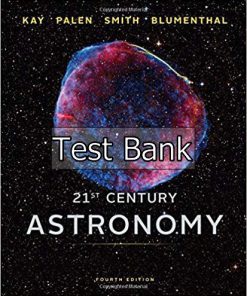$26.50$50.00 (-47%)
In stock
Taxation of Individuals and Business Entities 2014 5th Edition Spilker Test Bank.
You may also like
Instant download Taxation of Individuals and Business Entities 2014 5th Edition Spilker Test Bank pdf docx epub after payment.

Product details:
- ISBN-10 : 007763179X
- ISBN-13 : 978-0077631796
- Author: Brian Spilker (Author), Benjamin Ayers (Author), John Robinson (Author), Edmund Outslay (Author), Ronald Worsham (Author), John Barrick (Author), Connie Weaver (Author)
McGraw-Hill’s Taxation Series continues to provide a unique, innovative, and engaging learning experience for students studying taxation. The breadth of the topical coverage, the storyline approach to presenting the material, the emphasis on the tax and nontax consequences of multiple parties involved in transactions, and the integration of financial and tax accounting topics make this book ideal for the modern tax curriculum.
With over 275 schools adopting the 4th edition, McGraw-Hill’s Taxation of Individuals and Business Entities resonates with instructors who were in need of a bold and innovative approach to teaching tax. 350 professors have contributed 370 book reviews, in addition to 20 focus groups and symposia. These instructors were impressed on the book’s organization, pedagogy, and unique features that are a testament to the grassroots nature of this book’s development.
Table of contents:
Chapter 1: An Introduction to Tax
Chapter 1 Introduction
Who Cares About Taxes and Why?
What Qualifies as a Tax?
How to Calculate a Tax
Different Ways to Measure Tax Rates
Tax Rate Structures
Proportional Tax Rate Structure
Progressive Tax Rate Structure
Regressive Tax Rate Structure
Types of Taxes
Federal Taxes
State and Local Taxes
Implicit Taxes
Evaluating Alternative Tax Systems
Sufficiency
Equity
Certainty
Convenience
Economy
Evaluating Tax Systems—The Trade-Offs
Conclusion
Chapter 1: Summary
Chapter 1: Key Terms
Chapter 1: Discussion Questions
Chapter 1: Problems
Chapter 2: Tax Compliance, the IRS, and Tax Authorities
Chapter 2 Introduction
Taxpayer Filing Requirements
Tax Return Due Date and Extensions
Statute of Limitations
IRS Audit Selection
Types of Audits
Tax Law Sources
Legislative Sources: Congress and the Constitution
Judicial Sources: The Courts
Administrative Sources: The U.S. Treasury
Tax Research
Step 1: Understand Facts
Step 2: Identify Issues
Step 3: Locate Relevant Authorities
Step 4: Analyze Tax Authorities
Step 5: Document and Communicate the Results
Tax Professional Responsibilities
Taxpayer and Tax Return Preparer Penalties
Conclusion
Chapter 2: Summary
Chapter 2: Key Terms
Chapter 2: Discussion Questions
Chapter 2: Problems
Chapter 3: Tax Planning Strategies and Related Limitations
Chapter 3 Introduction
Basic Tax Planning Overview
Timing Strategies
Present Value of Money
The Timing Strategy When Tax Rates Are Constant
The Timing Strategy When Tax Rates Change
Income-Shifting Strategies
Transactions between Family Members and Limitations
Transactions between Owners and Their Businesses and Limitations
Income Shifting across Jurisdictions and Limitations
Conversion Strategies
Limitations of Conversion Strategies
Additional Limitations to Tax Planning Strategies: Judicially Based Doctrines
Tax Avoidance versus Tax Evasion
Conclusion
Chapter 3: Summary
Chapter 3: Key Terms
Chapter 3: Discussion Questions
Chapter 3: Problems
Chapter 4: Individual Income Tax Overview, Dependents, and Filing Status
Chapter 4 Introduction
The Individual Income Tax Formula
Gross Income
Character of Income
Deductions
Income Tax Calculation
Other Taxes
Tax Credits
Tax Prepayments
Dependents of the Taxpayer
Dependency Requirements
Filing Status
Married Filing Jointly and Married Filing Separately
Qualifying Widow or Widower (Surviving Spouse)
Single
Head of Household
Summary of Income Tax Formula
Conclusion
Appendix A: Dependency Exemption Flowchart (Part I)
Appendix B: Qualifying Person for Head of Household Filing Status Flowchart
Appendix C: Determination of Filing Status Flowchart
Chapter 4: Summary
Chapter 4: Key Terms
Chapter 4: Discussion Questions
Chapter 4: Problems
Chapter 4: Comprehensive Problems
Chapter 5: Gross Income and Exclusions
Chapter 5 Introduction
Realization and Recognition of Income
What Is Included in Gross Income?
Other Income Concepts
When Do Taxpayers Recognize Income?
Who Recognizes the Income?
Types of Income
Income from Services
Income from Property
Other Sources of Gross Income
Exclusion Provisions
Common Exclusions
Education-Related Exclusions
Exclusions That Mitigate Double Taxation
Sickness and Injury-Related Exclusions
Deferral Provisions
Income Summary
Conclusion
Appendix: 2021 Social Security Worksheet from Form 1040 Instructions
Chapter 5: Summary
Chapter 5: Key Terms
Chapter 5: Discussion Questions
Chapter 5: Problems
Chapter 5: Comprehensive Problems
People also search:
Taxation of Individuals and Business Entities 2014 5th Edition
Taxation of Individuals and Business Entities 2014 5th Edition pdf
Taxation of Individuals and Business Entities 2014
how are different business entities taxed
a tax on a persons or corporations income
a tax on individual and corporate income

